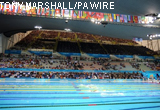 John Davies is a consultant anaesthetist in Lancaster, who takes part in motorsport as a competitor and as a rally doctor. He is volunteering as part of the Olympic Games medical team in the aquatic centre. Over the next couple of weeks he will be blogging from the Olympic Park about his experience during the Olympic Games.
John Davies is a consultant anaesthetist in Lancaster, who takes part in motorsport as a competitor and as a rally doctor. He is volunteering as part of the Olympic Games medical team in the aquatic centre. Over the next couple of weeks he will be blogging from the Olympic Park about his experience during the Olympic Games.
It’s raining men, and women! Practice time in the aquatic centre is very different from formal competition time. In the swimming pool every lane is filled with swimmers moving in both directions at once. At end of each lane, below the starting blocks, groups of swimmers stand in the shallow water talking to their coaches, waiting for a clear space to start their training swim, or just resting. Even more bizarrely to anyone not experienced in swim practice, some are swimming along with polystyrene floats, like a class of non-swimmers who are learning to swim, though the clue is that some hold the float between their ankles, and others are using snorkels. These are techniques to let the athlete concentrate on a single aspect of their stroke, but it looks more like a school visit albeit with a very disciplined class.
The diving pool, or “pit” as it is known, is more dramatic. During a competition, each diver will plunge in turn, from the same board, the only variation being the precise diving technique. During practice, every board including additional boards brought in for practice is in continuous use. The gallery behind the three metre triple spring boards, which allow the most spectacular dives, may have a queue of two or three athletes at a time waiting their turn to use the boards. The fixed boards at one, three, six, and the mighty ten metre level are also in continuous use. Every few seconds, there is a splash. Some are neat as the divers enter water with a high scoring, minimal disturbance of the surface. But some divers create an enormous splash as they try to perfect enormously difficult twists and somersaults as they plummet towards the water. For the medical team this is, shall we say, alarming, but the athletes are disciplined, wait their turn, and swim to the side strictly below their own board. If a falling diver should hit one swimming in the water below there would undoubtedly be a risk of severe injury to both.
Our alarm is compounded by a diver’s practice that isn’t seen in competition. They need their arms and legs to be dry, or at least not slippery with water, and their faces and hair need to be dry so that they don’t get water in their eyes as they perform. So each diver has a “chammy,” which is no longer a chamois leather, but a synthetic cloth with which they wipe and flap themselves as they await their turn to practise. As their turn comes, they throw the cloth to the floor from the board. Now a wet cloth falls as fast a human body, so as one watches the practice, looking out for any diver who might injure themselves, we continuously see out the corner of our eyes, a falling object which splats onto the pool surround. I’ve never seen someone fall thirty feet onto an unyielding tile surface, but I fear the sound effect would be similar.
As it is, our medical skills and equipment have yet to be needed, and long may that continue. The medical group with whom I am watching the divers is entirely composed of volunteers—”GamesMakers”—who are there for love of the sport, or for love of the Games’ ideal and excitement. An extensive selection process winnowed down a quarter of a million volunteers to 75,000 “GamesMakers,” who are helping to run the Games at the Olympic Park, and at many other venues around London and the UK. This elite “Field of Play” team includes anaesthetists, GPs with sports medicine experience, and A&E and ICU nurses. We make up just a part of the medical team for the aquatic centre, which also includes doctors, nurses, and first aiders who deal with problems among the spectators, and specialist sports doctors and physiotherapists to supplement those who have come with the national teams. The task of the “Field of Play” team—as it is at any Olympic venue—is to treat any Olympic athlete or team member who needs immediate medical care, on the field of play or anywhere else in the centre. Diving in the pool may be risky, but divers practise their techniques out of the water as well, in the “dry diving” area—a gym fitted with floor level trampolines and roof mounted bungee cord suspended belts so that the divers can launch themselves into the air to twist and somersault in warm dry circumstances, but without relatively yielding water below. Despite soft rubber mats, the risk of impact to limb and spine is obvious, and the “Field of Play” team is ready at those sessions as well as wet ones.
